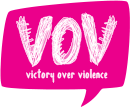The VOV Approach
![]() The VOV approach to violence prevention focuses on (1) examining the relationship between passive violence and physical violence as a model for understanding the cycle of violence, (2) promoting the role of virtue-based dialogue and action as a protective factor, primarily at the individual- and relationship-levels, but at the community- and societal-levels as well, and (3) understanding passive violence as a risk factor to be overcome at all levels. The elements of this approach fit within the typology of violence and multi-level ecological model for understanding violence published in the 2002 World Health Organization Report on Violence and Health which serves as the framework for organizing content on VOV.com.
The VOV approach to violence prevention focuses on (1) examining the relationship between passive violence and physical violence as a model for understanding the cycle of violence, (2) promoting the role of virtue-based dialogue and action as a protective factor, primarily at the individual- and relationship-levels, but at the community- and societal-levels as well, and (3) understanding passive violence as a risk factor to be overcome at all levels. The elements of this approach fit within the typology of violence and multi-level ecological model for understanding violence published in the 2002 World Health Organization Report on Violence and Health which serves as the framework for organizing content on VOV.com.
![]() Understanding that violence is a worldwide illness, the VOV campaign strives to foster global perspectives that identify and connect the root cause of conflicts from the individual-level to the relationship-, community-, and societal-levels. In this regard, VOV supports the United Nations Culture of Peace initiative and the Earth Charter initiative. The United Nations has defined the Culture of Peace as “a set of values, attitudes, modes of behavior and ways of life that reject violence and prevent conflicts by tackling their root causes to solve problems through dialogue and negotiation among individuals, groups and nations.” The brilliance of the Culture of Peace is that every single woman, man and child can contribute to creating it.
Understanding that violence is a worldwide illness, the VOV campaign strives to foster global perspectives that identify and connect the root cause of conflicts from the individual-level to the relationship-, community-, and societal-levels. In this regard, VOV supports the United Nations Culture of Peace initiative and the Earth Charter initiative. The United Nations has defined the Culture of Peace as “a set of values, attitudes, modes of behavior and ways of life that reject violence and prevent conflicts by tackling their root causes to solve problems through dialogue and negotiation among individuals, groups and nations.” The brilliance of the Culture of Peace is that every single woman, man and child can contribute to creating it.
Core Concepts
The philosophy underlying the VOV approach to violence prevention can be broken down into five core concepts. We strive to integrate these five concepts throughout all content areas of VOV.com to strengthen your experience of learning, reflection, and empowerment. As you continue to learn about these concepts and reflect on how they connect to your daily life, you can translate theory into action, empowering yourself to make nonviolence a daily practice.
Click to learn more about each of our Core Concepts.
The relationship between passive violence and physical violence
Passive violence is anything we say, think, or do that undermines the fundamental dignity of our own lives or the lives of others. Passive violence is (1) verbal/emotional abuse (ex: teasing, taunting, bullying, ostracizing), (2) oppression (ex: economic, political, cultural, religious, etc.), (3) apathy/indifference (choosing to step back and do nothing when you see acts of violence in your environment) or (4) negative mental judgments (dismissing someone or “profiling” them in our mind based on race, skin color, dress or other superficial quality – before getting to know them individually). Gandhi taught that passive violence is the fuel that feeds the fire of physical violence. Therefore, if we want to put out the fire of physical violence, logically we have to cut off the fuel supply. When we become conscious of the little things we do every day that are passively violent, we can make better decisions and help build the culture of peace.
The value of dialogue
Through the power of virtue-based dialogue, VOV encourages authentic respect, trust and friendship among people, families, schools and local communities across all boundaries that may divide such as race, nationality, religion, age, gender, language, ethnicity, disability, sexual orientation, etc. and recognition of the common humanity we all share.
Taking responsibility
Peace is not the absence of war or violence. Peace is an active process in which each person makes a commitment to take action each day for the uplift of human dignity.
The root cause of violence
VOV defines the root cause of violence as a lack of self-identity and hope for the future. People who lack confidence in who they are can develop an insecurity complex. They may compare themselves to others and criticize or judge them because they are different. A sense of worthlessness can lead to violence.
The multi-level ecological model for understanding violence
This public health model maps out factors that predict the likelihood of violence occuring on four playing fields of our lives: individual-, relationship-, community-, and societal-levels. By taking action to increase the number of protective factors and minimize the number of risk factors in your daily life, you can be proactive in decreasing the liklihood of violence occuring and help build the culture of peace. Virtues such as courage, compassion, and seeing the interconnectedness of our lives are examples of internal protective factors that VOV strives to help each person cultivate, starting at the individual-level.

